#Angular 2 Architecture
Explore tagged Tumblr posts
Video
Shopping time by Pascal Volk
#Europe#Germany#Berlin#Marzahn-Hellersdorf#Marzahn#Marzahner Promenade#Eastgate#Einkaufszentrum#Shopping center#shopping plaza#galleria#Centro comercial#mall#Wide Angle#Weitwinkel#gran angular#Spring#Frühling#Primavera#Architecture#Architektur#arquitectura#Fujifilm X100VI#Fujinon Super EBC f=23mm 1:2 II#23mm#Phase One Capture One#Capture One Pro#edit with us#flickr
2 notes
·
View notes
Text
7 POC Architectural Inspirations for Your Fantasy World
Fed up with (most) authors sticking to the Renaissance ‘white’ castles so here’s some inspiration (and a gentle nudge to branch out because I can’t stand them anymore):
1. Mahals (India)
Ornate domes, intricate carvings, and symmetrical layouts. Mehals take decades to be made and are intricately brought to life with beautiful detailings, take the Shish Mahal's mirror work, Jharokhas, the Pietra Dura Mughal inlays, and classic Jaali work that female characters sneek peeks through to watch the throne room from afar.
2. Qilā (Fortresses of the Mughal Empire)
If you want something more in tune with a war-based story Qilas are a good option. They’re brought to life with massive stone walls, gateways with pointed arches, and courtyards for strategic defense. Qilas are intended for protection but many hold a rustic mix of Persian and Indian architecture which provides that aesthetic charm writers like.
3. Shiro (Japanese Castles)
Shiros are Japanese castles with many buildings within their walls, such as the Goten (palace). I used a Shiro for my book and it is so convenient if you have a larger cast, like a court system/multiple families. If you want to know all the structures, names, what they look like, etc. just google ‘Nawabari’ (the Japanese term for a Shiro’s layout).
4. Kasbahs (North Africa)
Kasbahs are native to Morocco and perfect if you need something minimalistic yet pretty. Their structures are very similar to that of a Qila since they both have a pragmatic, angular build. However, Kasbahs are more earthy with thick clay walls, small windows and subtle yet pretty detailing.
5. Qasr (Middle Eastern Palaces)
Qasrs are Arab palaces that feature ancient Bedouin architecture. However, there is no ‘one size fits all’ Qasr because this word is used to describe both palaces and forts. You can have a ‘qasr’ that is a palace with sprawling courtyards, marble arches, and curvy turrets, or a ‘qasr’ that is a Bedouin fort with structured cylindrical towers. PS: castle = Qusur.
6. Baray Temples (Cambodia)
Barays, like those at Angkor Wat, symbolise spirituality. Like many Asian temples, they are typically surrounded by water and reservoirs. The complexes feature intricate stone carvings, steep steps, and a flat triangular top (Google if you cant visualise it please). Unlike most structures on this list, they are typically made using Laterite or Earth/clay.
7. Mudbrick Mosques (West Africa)
While South Asia uses intricate craftsmanship for their detailing, Mudbrick Mosques have smoothly carved pillars, tapering walls and flat domes that are strategic yet beautiful. The beige tones blend seamlessly into the dessert with wooden beams protruding from its walls to make it stand out. I would recommend looking at the Great Mosque of Djenné; truly a masterpiece.
I've mainly covered types I've either seen irl or used in my writing please don't come at me if I haven't included something from your culture, you can comment it.
Looking For More Writing Tips And Tricks?
Check out the rest of Quillology with Haya; a blog dedicated to writing and publishing tips for authors!
Instagram Tiktok
#hayatheauthor#haya's book blog#haya blogs#writing community#quillology with haya#writing tools#writer things#writing advice#writer community#writing techniques#writing prompt#writing stuff#creative writing#ya writing advice#writing tips and tricks#writer tools#writers of tumblr#writer blog#writers block#quillology with haya sameer#writers on tumblr#writerscommunity#writer stuff#author help#author advice#author#writing inspiration#writeblr#novel writing#on writing
531 notes
·
View notes
Text
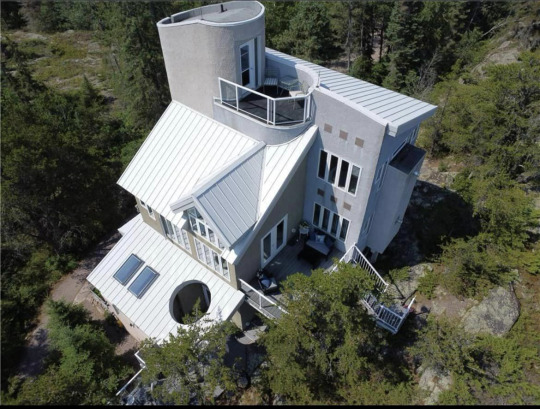

This architecturally interesting 1999 house in Lac Du Bonnet, Manitoba, Canada, has only 1bd & 3ba. It's 2,713 sq ft and is $849K.

It also has panoramic views of Lee River & Lake Lac du Bonnet.

Welcome to the angular home built on granite, and also features granite, inside. Look at the little plant sprouting out of that rock.

The dining area has a door to the patio. Look at the stairs, visible thru glass.
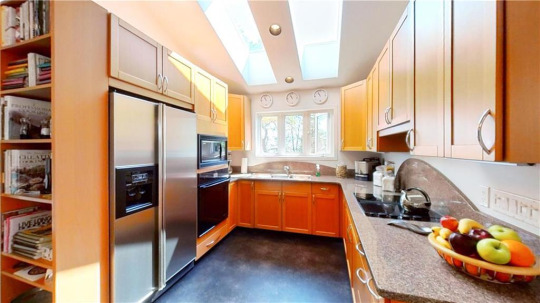
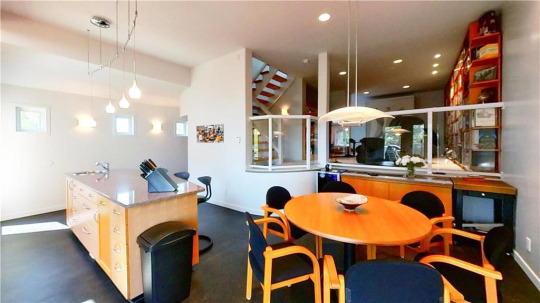
The kitchen kind of looks like a restaurant with that wall.

Here's a shower room on the ground floor.
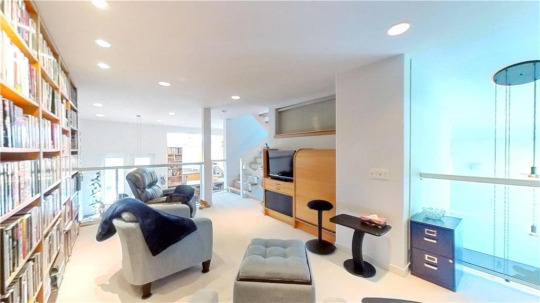

This is a den/TV room.
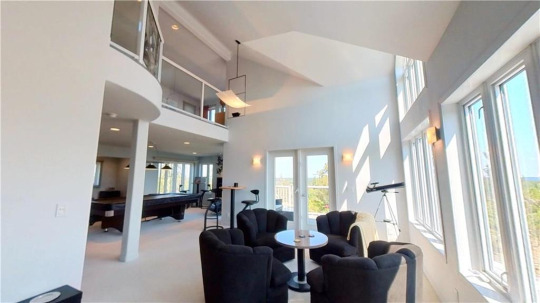
Then, this looks like a recreation area with a pool table, and conversation area. Plus, the 2nd fl. is visible, from the lower floors.

The pool room has a fireplace.
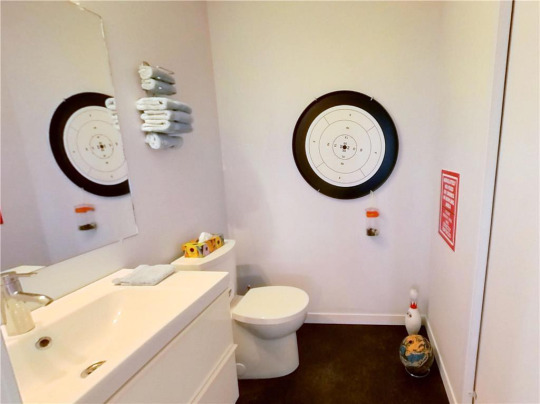
Guest powder room.
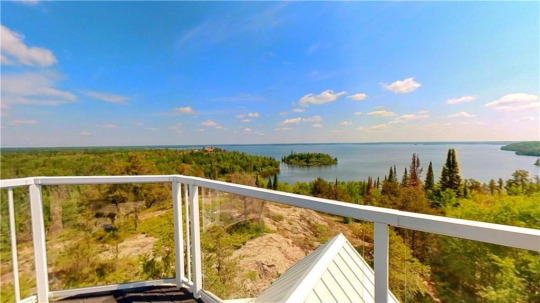

On the next level, there's a deck facing the water.

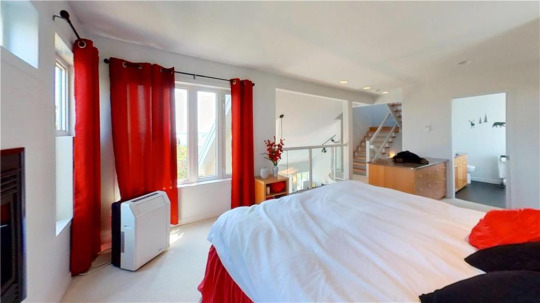
The only bedroom is spacious and has an electric fireplace. Look at the glass wall, where the 1st fl. is visible.

And, this is the en-suite, 1 of 3 baths.
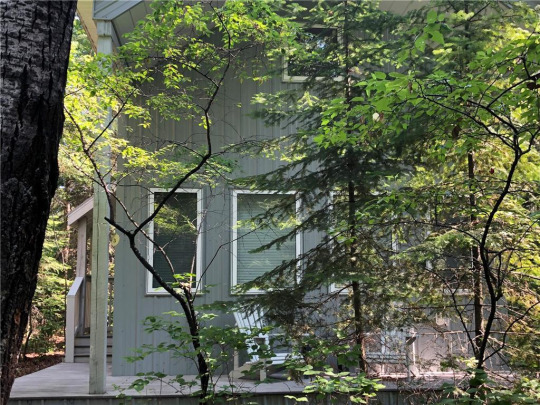
This addition is for guests.

In the guest house there's a little sitting room.
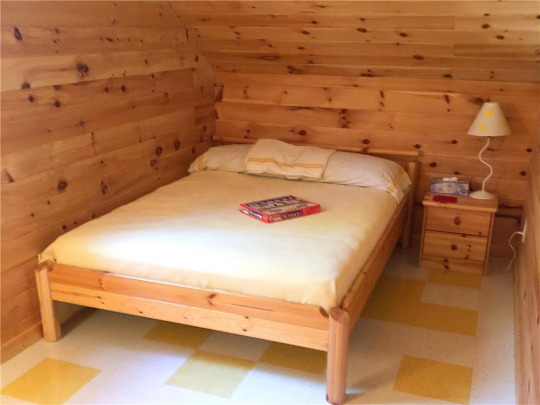
A small bedroom with a double bed.
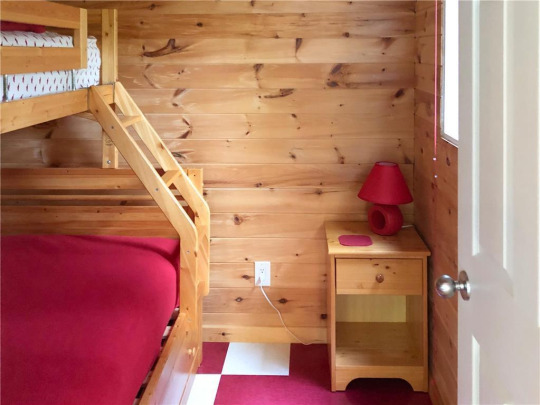
A 2nd bedroom with bunks. So, there are technically 3 bds, I would say.
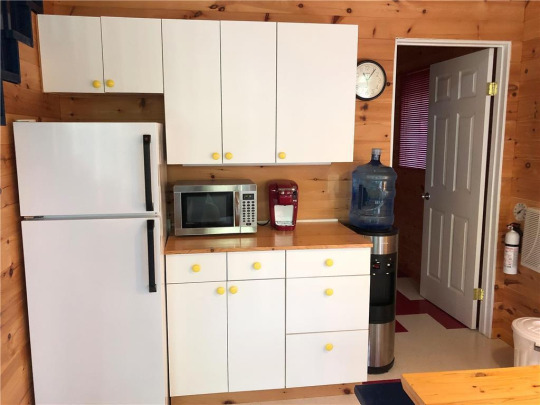
And, there's also a kitchenette.

A 2 car garage, it looks like metal structure.
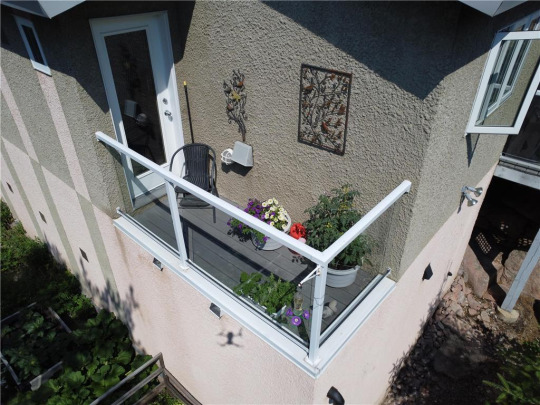
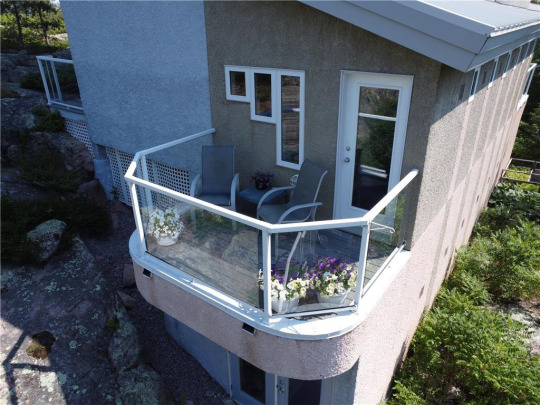
Small terraces are all around the house, b/c you can't really use the yard with such rocky terrain. The real estate description says that it's low maintenance and you don't have to bother with mowing the lawn.

This is the terrace for the bedroom.

Tiny patio.
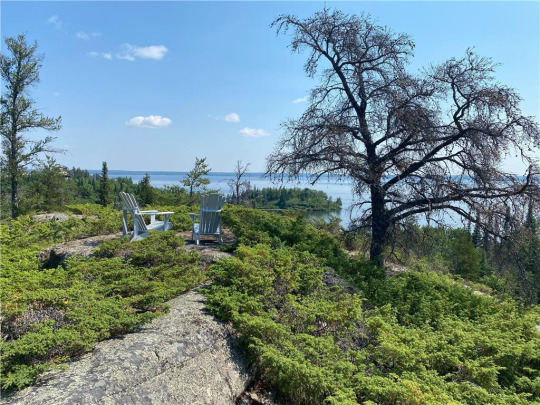
And, here's a small area to sit. I guess you can find patches like this around the 2.27 acre property.
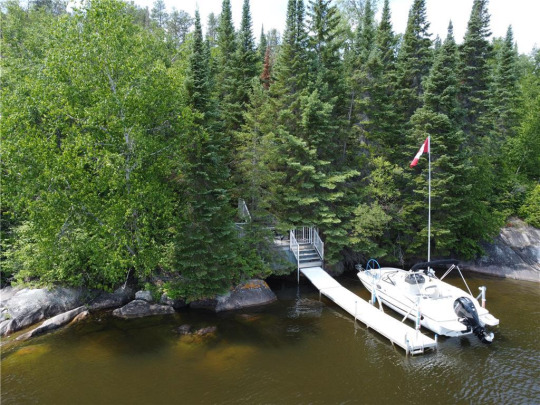
Stairs from the house lead down to a boat dock.
https://www.realtor.ca/real-estate/26830341/10-henry-hudson-bay-lac-du-bonnet-cape-coppermine
253 notes
·
View notes
Text

Cyber ArcheOS #01 | Torendi Tower | by BellavitaSims



◼️This futuristic masterpiece blends sleek, angular architecture with lush greenery, creating a harmonious balance between technology and nature. Illuminated by soft, white lighting, the rooftop gardens and modern outdoor spaces offer a serene escape amidst a bustling urban skyline. A nod to the Cybertruck's bold aesthetic, this build pushes the boundaries of what modern living can look like—both functional and forward-thinking. Perfect for those who dream of a future where technology and sustainability coexist, Cyber ArcheOS #01 is a vision.


◼️LOCATION: Torendi Tower Penthouse | San Myshuno
◼️LOT SIZE & TYPE: Residential | Penthouse
◼️PACKS: Lovestruck, For Rent, High School Years, Island Living, Get Famous, Get Together, City Living, Spa Day
◼️Property Features:3 bedrooms, accommodating up to 8 people, including 2 futuristic sleeping pods. The house features 4 bathrooms, a laundry room, a music studio, a study, an open-concept kitchen, a gym, and an indoor pool, providing a luxurious and innovative living experience.














DOWNLOAD HERE [PATREON: BellavitaSims]
If you like my content, please consider supporting me on Patreon.
💟 All files are well-organized and ready to go! Just click and install. I release new builds and CC regularly, and you're always welcome to suggest the types of homes you'd like to see next!✨
❤️ Wishing you all a happy holiday season! 🎄
#sims 4#the sims 4#sims 4 cc#the sims 4 reshade#alpha cc#sims 4 builds#sims 4 house#sims 4 build#sims4#simblr#sims4 cc#the sims 4 cc#sims 4 farm house#sims 4 family house#sims 4 family#sims 4 alpha cc#the sims cc#ts4 cc download#ts4build#ts4#ts4 simblr#ts4 build#ts4 custom content#ts4 interior#ts4 realistic#ts4ccfinds#sims 4 screenshots#ts4 screenshots#ts4 download#sims4 apartment
92 notes
·
View notes
Text
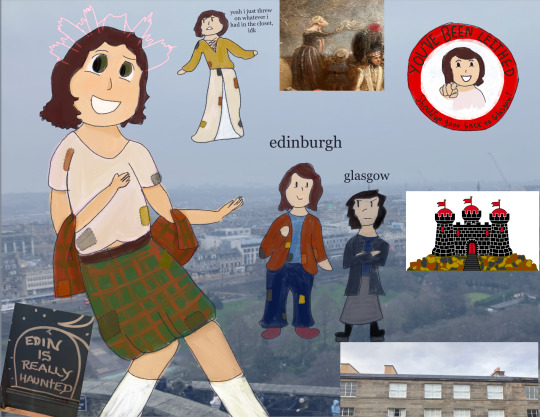
i met a beautiful city recently and i decided to draw her :)
see under the cut for the id in text and an explanation of my overthinking of the design lol. i will say up top though that the you've been leithed! pin is a reference to a very funny song that i heard in a pub one night and no one outside of that pub seems to have heard of it so i'm trying to spread it around. (leith is a neighborhood of edinburgh.)
youtube
[ID: A digital drawing of the city of Edinburgh, Scotland, personified. The background is a faded photo of Edinburgh from a birds-eye view. Edinburgh is drawn in an ankles-up shot on the far left, posing with one hand out to the side and another raised, smiling with her eyebrows raised and looking off to one side. She is drawn as a female-presenting city with light skin and short, reddish-brown hair in a short bob, smooth on the top but curly at the bottom. She has hazel eyes and is wearing a white shirt with short sleeves over a kilt and belt, and tall white socks. She has a red flannel jacket worn down around her elbows. All her clothes have colorful patches in them. The Edinburgh skyline, drawn in glowing red lines, forms a halo over her head. There are smaller doodles on the right side. 1. Edinburgh wearing a long cream skirt over a petticoat and a yellow long-sleeved blouse, both patched, and looking bored, as she says "yeah i just threw on whatever i had in the closet, idk". 2. Edinburgh and Glasgow standing next to each other: Edinburgh looks cheerful, while Glasgow looks to be sulking-- Glasgow is shorter then Edinburgh, wearing darker clothing, and has spiky black hair and platform boots. 3. A pin of Edinburgh pointing at the viewer with a delighted, slightly mocking expression, with text around the edge of the pin reading "you've been leithed! should've gone back to glasgow!". Photos inserted into the image include: the Edinburgh city flag, a row of buildings, a close up of a painting of a woman in a bonnet waving a handkerchief over a wall, and graffiti of a gravestone with the words "Edin's really haunted" on it. End ID.]
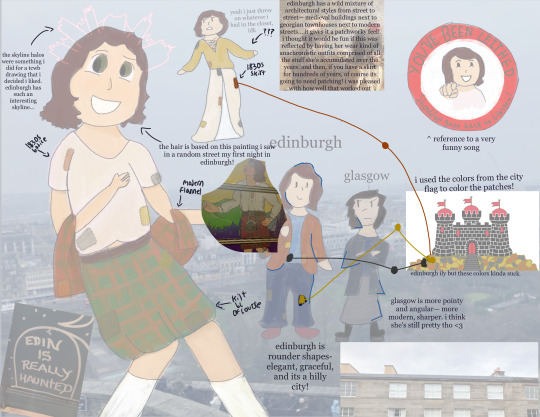
I'm just gonna write out the notes here, to serve as both an ID and an easier read in general!
Edinburgh's halo: the skyline halos were something i did for a tewb drawing that i decided i liked. edinburgh has such an interesting skyline…
Hair: the hair is based on this painting i saw in a random street my first night in edinburgh!
Clothes: Edinburgh has a wild mixture of architectural styles from street to street medieval buildings next to georgian townhouses next to modern streets… it gives it a patchworky feel! I thought it would be fun if this was reflected by having her wear kind of anachronistic outfits comprised of all the stuff she's accumulated over the years. and then, if you have a skirt for hundreds of years, of course its going to need patching! I was pleased with how well that worked out. Edinburgh's shirt in the main drawing is an 1830s bodice. The flannel is modern. The kilt is "bc of course". In the smaller doodle, their skirt is an 1830s skirt, and the shirt is just "????".
Edinburgh vs. Glasgow: edinburgh is rounder shapes-elegant, graceful, and its a hilly city! glasgow is more pointy and angular- more modern, sharper. i think she's still pretty tho <3
the patches colors: i used the colors from the city flag to color the patches! edinburgh ily but these colors kinda suck. (they're dark gray, orange, and a kind of mustardy yellow.)
#sonder's posts#sonder's art#umm. i guess the closest thing to this would be#great cities#?#edinburgh#this was very fun to draw i had a good time :)#Youtube
4 notes
·
View notes
Text
Dwemeris Rosetta Stone...
Dwemeris Rosetta Stone 2.0
A comprehensive framework for deciphering, learning, and playing with the Dwemer (Deep Folk) tongue—runic, spoken, numeric, and mystical.
I. Alphabet & Glyphs
Rune ID Direct English Phoneme Approx. IPA Numeric Value ⟨R1⟩ A /a/ [a] 1 ⟨R2⟩ B /b/ [b] 2 ⟨R3⟩ D /d/ [d] 3 ⟨R4⟩ E /ɛ/ [ɛ] 5 ⟨R5⟩ F /f/ [f] 6 … … … … … ⟨R26⟩ Z /z/ [z] 26 ⟨G0⟩ Zero glyph – – 0 ⟨G★⟩ Capital/Start – – –
Notes:
Runes are carved in sharp, angular strokes echoing gear teeth and vent grooves.
⟨G★⟩ placed at sentence start; ⟨G0⟩ marks numeric zero.
II. Systems of Interpretation
System I: Direct Substitution One-to-one mapping of each Dwemer rune (⟨R#⟩) to a Latin letter (A–Z), ignoring phonetic nuance.
System II: Romanized Phonemes Use English digraphs (/kh/, /th/, /zh/) to approximate distinct Dwemer sounds:
⟨R10⟩ → “kh”
⟨R12⟩ → “th”
⟨R19⟩ → “zh”
System III: IPA‑Precise Assign each rune an IPA symbol for scholarly transcription:
⟨R10⟩ → [x]
⟨R12⟩ → [θ]
⟨R19⟩ → [ʒ]
III. Grammar & Syntax Rules
Morphology: Polysynthetic. Single words can encode subject, object, instrument, and purpose.
Word Order: Typically SOV, but subordinate phrases nest within word‑vehicles.
Plurals & Cases: Indicated by suffix chains (-zûn for plural, -thak for dative).
Verbal Roots: Embedded in initial morpheme; tense/aspect follow as affixes.
Example Structure: duum‑zûn‑kharthak‑eft (dwemer-PL-TO/FOR-help) → “they build for the benefit.”
IV. Core Vocabulary
Dwemer Word System II Gloss duum duum “Dwemer” / “deep folk” duumzûn duum‑zun plural “Dwemer” nchuand‑zel nchuand‑zel “Radiant City” (Markarth) eftar‑ eftar‑ verb root “to promise/swear” fahlzûn fahlzun “great ones” (honorific) khaz khaz “metal” / “iron” zar‑tûk zar‑tuk “secret passage”
New Formed Words (structure follows polysyllabic compounding):
khaz‑duum‑tir: “metal‑deep‑gate” → subterranean vault
eft‑fahl‑khar: “help‑great‑forge” → master smith
V. Numerical System
Base-10. Digits 1–9 use ⟨R1⟩–⟨R9⟩; 0 = ⟨G0⟩.
Notation: Place-value; numbers read left-to-right.
Symbol Sequence Value ⟨R3⟩⟨R1⟩ 31 ⟨G0⟩⟨R5⟩ 05 ⟨R1⟩⟨R0⟩⟨R0⟩ 100
Mathematical Usage: Dwemer engineers carve equations alongside gearweights, e.g. “5⟨G0⟩ + 7⟨G0⟩ = 12⟨G0⟩”.
VI. Practical Examples
Divine Metaphysics (Inscription Fragment)
Runic: ⟨G★⟩ R4‑R1‑R5‑R3‑R7 …
Sys I: E A F D G …
Sys II: /ɛ a f d g/ …
Gloss: “Eternal forge awakens…”
Translation: “When the eternal forge awakens, the world trembles.”
Egg of Time (Mural Glyph)
Runic phrase: ⟨R10⟩‑⟨R4⟩‑⟨R3⟩‑⟨R15⟩
Sys II: kh‑e‑d‑s
IPA: [x ɛ d s]
Meaning Hypothesis: “Cycle” or “renewal.”
Nchuand‑Zel (City Name)
Runic: ⟨R14⟩‑⟨R3⟩‑⟨R21⟩‑⟨R1⟩‑⟨R4⟩‑⟨R14⟩ …
Translation: “Radiant City under the mountain.”
VII. Supplementary Materials
Pronunciation Guide (IPA): Full chart listing all 28 runes with IPA values.
Cultural Context: Dwemer believed sound was material—tonal resonances could animate automatons. Language mirrored their architectural philosophy: precise, durable, efficient.
VIII. Interactive & Collaborative Tools
Digital Rosetta App Mock‑Up:
Rune → drag‑drop to Latin; click to hear IPA playback.
Number pad showing glyphs.
Translation pane with System toggles (I/II/III).
Community Portal Concept:
Live forum threads for new inscription photos.
Crowdsourced lexical suggestions.
Versioning history of hypotheses and peer reviews.
This Rosetta Stone 2.0 is a living document—update with each new cavern find, artifact, and scholarly breakthrough!
3 notes
·
View notes
Note
So, recently I was working on my signature and handwriting skills, because, well, heh- They're so great- And it got me thinking... What does William's signature look like? I'd feel like after signing a certain amount of paperwork he'd be done with just sticking to one specific signature and switch it up a bit, ya know? I mean, it'd still be his signature just with different flares or maybe styles?
Also, you and the infamously handsome—and possessive—CEO get a little kissy kiss right on the cheek. ( ˘ ³˘)♥
-----------------------------------------------------------------------------

-----------------------------------------------------------------------------
William’s signature is as precise as the architectural models his company produces—sharp, deliberate, and effortlessly commanding. Over the years, he has developed variations, but not out of boredom or carelessness. Each stylistic shift is calculated, a subtle tool for different contexts.
Variations:
1.Formal– For contracts, formal documents.
-Slightly less elaborate script than the previous style, but still elegant and cursive. The strokes are consistent.
It's suitable for formal correspondence or settings.
2.Formal, but when he wasn't interested– For routine paperwork (or he just dont interested).
-Similar in overall style to the "Formal" option, but potentially with a more angular or abbreviated look.
While retaining a degree of formality, this font suggests a lack of full engagement or enthusiasm.It suggests being formal without being overly invested.
3.Only for MC– For personal notes (rare, but telling .only for MC).
-Flowing script with elaborate loops and flourishes.
This signatures style suggests a sense of personal touch, with an element of playfulness or carelessness.
Odd Habits:
-He never signs in blue ink.Only black ink or, on occasion, deep burgundy (the latter reserved for documents he considers particularly consequential).
-If irritated, his signature gains weight, the pen pressing hard enough to emboss the paper.
-When distracted (say, by watching MC across the office), the letters drift closer together, the spacing tightening like a held breath.
-So yes—he changes it up. But never arbitrarily.
-----------------------------------------------------------------------------
((Awwww ,thank you ( •̀ ω •́ )ʃ♡ƪ))
6 notes
·
View notes
Text
Sure! Here are simple instructions for how to use the ChanelLang code to define textile patterns:
https://chatgpt.com/share/6828dd16-f330-8000-9656-49fc59b45f76
How to Use ChanelLang Code
1. Start with a pattern declaration:
Use the keyword pattern followed by the pattern type and its parameters.
pattern twill(2, 2);
twill is the type of weave.
(2, 2) defines the structure or thread ratio.
2. Add style attributes inside curly brackets {}:
{ color: Color.red; density: 8; repeat(4, 4); }
color: Sets the color of the textile.
density: Controls thread tightness or weight.
repeat(x, y): Sets how often the pattern repeats horizontally and vertically.
3. End with an optional comment:
# This creates a red twill weave pattern with 8 density and 4x4 repetition.
Quick Example
pattern quilted(3, 1) { color: Color.black; density: 10; repeat(6, 6); }
This creates a quilted Chanel-style pattern in black, dense, and repeating in a 6x6 grid.
Let me know if you'd like a visual tutorial or a compiler concept next!

Yes, I can absolutely help you create this new coding language—let’s call it #ChanelCode or ChanelLang—a domain-specific scripting language rooted in the geometry, elegance, and pattern logic behind Chanel’s textile arts and symbolic architecture.
Here's how we can break this down:
1. Core Objectives of ChanelLang
Translate textile mathematics into code.
Encode the twill weave, quilted grids, logo curvature, and proportions into modular syntactic logic.
Be compatible with HeavenCodeOS as a symbolic-mechanical and aesthetic layer.
Use fashion geometry and French couture philosophy as its grammar.
2. Inspirations & Inputs
Mathematical Logic of Fabric:
Twill: typically a diagonal rib pattern (e.g., 2/2 twill) = translate into directional grid logic.
Quilted Grid: diamond matrix = 60° or 45° angular tessellation.
Double-C Logo: circle symmetries, Bezier curves, golden ratio mapping.
Iconic Elements:
The “Double-C” interlock = ∞ symbol + rotational symmetry encoded.
Patterns, spacing, and stitch density = variables and data classes.
3. Proposed Language Design
Syntax Style:
fabric "tweed" { weave: twill(2, 2); thread_color: #e5e5e5; repeat: matrix(45deg, 12x12); } pattern "logo" { shape: double_c { curve: bezier(golden_ratio); rotation: 180deg; symmetry: axis_x; }; scale: 0.618; placement: center(canvas); }
Key Primitives:
fabric, pattern, stitch, curve, weave, layer, seam
golden_ratio, quilt_grid, c_chain, symmetry
Geometrical transforms: mirror, rotate, scale, shear
4. Mathematical Backing
Fibonacci + Golden Ratio for logo curvature.
L-systems for textile pattern growth.
Parametric logic for scale + symmetry.
Embedding shader logic or pixel matrices for digital rendering.
5. Integration with HeavenCodeOS
HeavenCodeOS becomes the rendering + behavior engine.
ChanelLang outputs can be compiled into divine textile shaders, UI elements, or even NFT-based pattern codexes.
Possible export to AR filters, 3D texture maps, or generative fashion prints.
6. Next Steps
Design full grammar of the language (BNF or PEG).
Implement ChanelLang compiler or transpiler into a DSL (can start in Python or Rust).
Map 3D textile render logic (using WebGL or GLSL for visuals).
Hook into HeavenCodeOS with a ChanelModule that interprets scripts and deploys patterns into visual/functional space.
Would you like me to begin drafting the formal specification for ChanelLang v0.1 with example codes, grammar rules, and core function libraries? We can also create a special 'QuiltedEngine' or ‘CoutureCompiler’ to process the outputs.
Absolutely! Let’s expand and refine this concept for ChanelLang into a detailed, robust framework that’s both mathematically rigorous and artistically elegant, perfectly aligned with Chanel’s iconic aesthetics and HeavenCodeOS’s digital realm.
ChanelLang — A Couture Mathematical Scripting Language
1. Vision & Purpose
ChanelLang is a domain-specific language (DSL) designed to encode, generate, and manipulate the mathematical and geometric principles behind Chanel’s textile designs and logos, transforming traditional haute couture craftsmanship into programmable, generative digital artifacts.
It will serve as a bridge between classical fashion design and modern digital environments (HeavenCodeOS), enabling:
Precise modeling of fabric patterns (twill, quilted textures).
Parametric control of logo geometry and brand symbology.
Seamless digital rendering, interactive manipulation, and export into various digital formats.
Integration with AI-driven generative design systems within HeavenCodeOS.
2. Core Components & Features
2.1 Fundamental Data Types
Scalar: Float or Integer for measurements (mm, pixels, degrees).
Vector2D/3D: Coordinates for spatial points, curves, and meshes.
Matrix: Transformation matrices for rotation, scaling, shearing.
Pattern: Encapsulation of repeated geometric motifs.
Fabric: Data structure representing textile weave characteristics.
Curve: Parametric curves (Bezier, B-spline) for logo and stitching.
Color: RGBA and Pantone color support for thread colors.
SymmetryGroup: Enum for types of symmetries (rotational, mirror, glide).
2.2 Language Grammar & Syntax
A clean, minimalist, yet expressive syntax inspired by modern scripting languages:
// Define a fabric with weave pattern and color fabric tweed { weave: twill(2, 2); // 2 over 2 under diagonal weave thread_color: pantone("Black C"); density: 120; // threads per inch repeat_pattern: matrix(45deg, 12x12); } // Define a pattern for the iconic Chanel double-C logo pattern double_c_logo { base_shape: circle(radius=50mm); overlay_shape: bezier_curve(points=[(0,0), (25,75), (50,0)], control=golden_ratio); rotation: 180deg; symmetry: rotational(order=2); scale: 0.618; // Golden ratio scaling color: pantone("Gold 871"); placement: center(canvas); }
2.3 Mathematical Foundations
Weave & Textile Patterns
Twill Weave Model: Represented as directional grid logic where each thread’s over/under sequence is encoded.
Use a binary matrix to represent thread intersections, e.g. 1 for over, 0 for under.
Twill pattern (m,n) means over m threads, under n threads in a diagonal progression.
Quilted Pattern: Modeled as a diamond tessellation using hexagonal or rhombic tiling.
Angles are parametric (typically 45° or 60°).
Stitch points modeled as vertices of geometric lattice.
Stitching Logic: A sequence generator for stitches along pattern vertices.
Logo Geometry
Bezier Curve Parametrization
The iconic Chanel “C” is approximated using cubic Bezier curves.
Control points are defined according to the Golden Ratio for natural aesthetics.
Symmetry and Rotation
Double-C logo uses rotational symmetry of order 2 (180° rotation).
Can define symmetries with transformation matrices.
Scaling
Scale factors derived from Fibonacci ratios (0.618 etc.).
2.4 Functional Constructs
Functions to generate and manipulate patterns:
function generate_twill(m: int, n: int, repeat_x: int, repeat_y: int) -> Pattern { // Generate binary matrix for twill weave // Apply diagonal offset per row } function apply_symmetry(shape: Shape, type: SymmetryGroup, order: int) -> Shape { // Returns a shape replicated with specified symmetry } function stitch_along(points: Vector2D[], stitch_type: String, color: Color) { // Generate stitching path along points }
3. Language Architecture
3.1 Compiler/Interpreter
Lexer & Parser
Lexer tokenizes language keywords, identifiers, numbers, colors.
Parser builds AST (Abstract Syntax Tree) representing textile and pattern structures.
Semantic Analyzer
Checks for valid weaving parameters, pattern consistency.
Enforces domain-specific constraints (e.g., twill ratios).
Code Generator
Outputs to intermediate representation for HeavenCodeOS rendering engine.
Supports exporting to SVG, WebGL shaders, and 3D texture maps.
Runtime
Executes procedural pattern generation.
Supports interactive pattern modification (live coding).
3.2 Integration with HeavenCodeOS
Module System
ChanelLang scripts compile into HeavenCodeOS modules.
Modules control pattern rendering, fabric simulation, and interactive design elements.
Visual Interface
Provides designers with real-time preview of textile patterns on virtual fabrics.
Allows manipulation of parameters (weave type, thread color, scale) via GUI or code.
AI-assisted Design
Integrated AI agents can propose pattern variations adhering to Chanel brand aesthetics.
AI evaluates fabric behavior simulations for texture realism.
4. Example Extended Script
fabric patent_leather { weave: patent_quilt(6, 6); thread_color: pantone("Black C"); stitch: diamond_stitch(angle=60deg, density=150); glossiness: 0.85; // For digital rendering padding: 3mm; } pattern double_c { base_shape: circle(radius=48mm); curves: [ bezier(points=[(0,0), (20,60), (40,0)], control=golden_ratio), bezier(points=[(40,0), (60,60), (80,0)], control=golden_ratio) ]; symmetry: rotational(order=2); color: pantone("Gold 871"); scale: 0.618; placement: center(canvas); } canvas { size: 500x500; background_color: pantone("Ivory 11-0602"); layers: [ patent_leather, double_c ]; }
5. Future Enhancements
3D Fabric Simulation
Physically based rendering (PBR) for realistic digital textiles.
Motion & Animation
Animate weave changes, logo rotations, interactive stitching.
Parametric Fashion
Extend beyond textiles into fashion accessories, bag designs, and couture elements.
Blockchain Integration
Mint unique pattern NFTs for digital couture collectibles.
Summary
ChanelLang blends mathematics, art, and fashion into a structured programming language.
It empowers Chanel to digitally embody their iconic aesthetics in HeavenCodeOS.
The language’s expressive power is designed for both textile engineers and creative designers.
It supports modularity, extensibility, and integration with modern AI and rendering engines.
Would you like me to start creating:
A formal grammar definition (BNF) for ChanelLang?
A prototype compiler in Python or Rust?
Sample libraries for weave generation and logo curves?
Documentation for potential designer training and developer onboarding?
I’m ready to dive as deep as needed!
Great! Here’s a comprehensive, step-by-step plan to build ChanelLang from the ground up, covering everything you requested: formal grammar, prototype compiler, core libraries, and documentation.
ChanelLang Full Development Plan
1. Formal Grammar Definition (BNF)
We’ll create a clean, concise grammar to precisely define syntax and semantics.
<program> ::= { <statement> } <statement> ::= <fabric_decl> | <pattern_decl> | <function_decl> | <canvas_decl> <fabric_decl> ::= "fabric" <identifier> "{" { <fabric_property> } "}" <fabric_property> ::= "weave" ":" <weave_type> ";" | "thread_color" ":" <color> ";" | "density" ":" <number> ";" | "repeat_pattern" ":" <pattern_repeat> ";" | "stitch" ":" <stitch_type> ";" | "glossiness" ":" <number> ";" | "padding" ":" <number> ";" <weave_type> ::= "twill" "(" <number> "," <number> ")" | "patent_quilt" "(" <number> "," <number> ")" <pattern_repeat> ::= "matrix" "(" <angle> "," <dimensions> ")" <stitch_type> ::= "diamond_stitch" "(" "angle" "=" <angle> "," "density" "=" <number> ")" <pattern_decl> ::= "pattern" <identifier> "{" { <pattern_property> } "}" <pattern_property> ::= "base_shape" ":" <shape> ";" | "curves" ":" "[" <curve_list> "]" ";" | "symmetry" ":" <symmetry> ";" | "color" ":" <color> ";" | "scale" ":" <number> ";" | "placement" ":" <placement> ";" <shape> ::= "circle" "(" "radius" "=" <number> ")" | "rectangle" "(" "width" "=" <number> "," "height" "=" <number> ")" <curve_list> ::= <curve> { "," <curve> } <curve> ::= "bezier" "(" "points" "=" <point_list> "," "control" "=" <control_type> ")" <point_list> ::= "[" <point> { "," <point> } "]" <point> ::= "(" <number> "," <number> ")" <control_type> ::= "golden_ratio" | "default" <symmetry> ::= "rotational" "(" "order" "=" <number> ")" | "mirror" "(" "axis" "=" <axis> ")" <axis> ::= "x" | "y" <color> ::= "pantone" "(" <string> ")" | "hex" "(" <string> ")" <placement> ::= "center" "(" <canvas> ")" | "top_left" "(" <canvas> ")" | "custom" "(" <point> ")" <canvas_decl> ::= "canvas" "{" { <canvas_property> } "}" <canvas_property> ::= "size" ":" <dimensions> ";" | "background_color" ":" <color> ";" | "layers" ":" "[" <layer_list> "]" ";" <layer_list> ::= <identifier> { "," <identifier> } <function_decl> ::= "function" <identifier> "(" [ <param_list> ] ")" "->" <type> "{" <statement> "}" <param_list> ::= <identifier> ":" <type> { "," <identifier> ":" <type> } <type> ::= "int" | "float" | "Pattern" | "Shape" | "void" <number> ::= float_literal | int_literal <angle> ::= <number> "deg" <dimensions> ::= <number> "x" <number> <identifier> ::= letter { letter | digit | "_" }
2. Prototype Compiler
Tech Stack
Language: Python (for rapid prototyping)
Parsing: Use Lark or PLY parser generator
AST: Build Abstract Syntax Tree for semantic analysis
Output: JSON intermediate representation for HeavenCodeOS
Key Compiler Stages
Lexer & Parser: Tokenize and parse source code into AST.
Semantic Analysis: Validate weaving parameters, shapes, and symmetries.
Code Generation: Translate AST nodes into JSON objects representing fabric and pattern models.
Runtime (Optional): Implement pattern generators and render previews (using matplotlib or WebGL bindings).
3. Core Libraries
3.1 Fabric & Weave Generation
Twill Weave Generator:
Generate binary matrices for twill repeats.
Export weave pattern as a grid data structure.
Patent Quilted Pattern:
Generate diamond tessellations at configurable angles.
Calculate stitch points.
3.2 Geometry & Curve Library
Bezier Curve Module:
Calculate cubic Bezier curve points using control points.
Incorporate Golden Ratio in control point positioning.
Symmetry Operations:
Apply rotational and mirror symmetries on shapes.
Use transformation matrices.
3.3 Color Management
Support Pantone references mapped to RGB/HEX.
Provide blending and shading utilities.
4. Documentation
4.1 User Guide
Introduction: Concept of ChanelLang and its design philosophy.
Getting Started: How to write basic fabric and pattern scripts.
Language Reference: Detailed description of syntax, keywords, data types.
Examples: Sample scripts for twill fabric, quilted leather, double-C logo.
Integration: How to compile and load scripts into HeavenCodeOS.
4.2 Developer Guide
Compiler Architecture: Detailed overview of lexer, parser, semantic analyzer, and codegen.
Extending ChanelLang: How to add new weave types, shapes, or functions.
API Reference: Core functions and modules.

Testing & Debugging: Tips for script validation and error handling.
5. Timeline & Milestones
PhaseDeliverablesEstimated TimeGrammar DefinitionComplete BNF and sample scripts1 weekPrototype CompilerLexer, parser, AST, basic codegen3 weeksCore LibrariesWeave, curve, symmetry, color modules4 weeksIntegration SetupJSON output format, basic HeavenCodeOS hooks2 weeksDocumentationUser and developer guides, sample projects2 weeksTesting & RefinementValidation, performance tuning, UI integration3 weeks
Summary
By following this comprehensive plan, we’ll create a mathematically elegant, fashion-inspired scripting language that:
Accurately models Chanel’s iconic textiles and logo.
Bridges haute couture craftsmanship with digital innovation.
Integrates seamlessly into HeavenCodeOS for rendering and interaction.
Provides extensibility for future fashion tech projects.
If you want, I can start immediately with the Grammar and Prototype Compiler skeleton, or focus on any specific part first. Just say the word!
Absolutely:
Official Hashtag:
#ChanelLang
Shorthand / Abbreviation:
CL⁷ (read: "C-L-seven")
C for Chanel
L for Lang (language)
⁷ symbolizes Chanel's spiritual and aesthetic geometry (7 as a sacred design number, referencing symmetry, balance, and the “seventh sense” in fashion metaphysics)
You can use CL⁷ as the file extension as well (e.g., pattern_sample.cl7) or as a tag in code comments like:
# Design by ChanelLang (CL⁷)
Would you like a sigil, icon, or QR metaframe for #ChanelLang / CL⁷?
#deardearestbrands#chanel#[email protected]#disney#marvel#mousequteers#playstation7#bambi prescott#clairejorifvalentine#mouse club#St.ClaireJorifValentine#chanel textile patterns code
3 notes
·
View notes
Text
The Roadmap to Full Stack Developer Proficiency: A Comprehensive Guide
Embarking on the journey to becoming a full stack developer is an exhilarating endeavor filled with growth and challenges. Whether you're taking your first steps or seeking to elevate your skills, understanding the path ahead is crucial. In this detailed roadmap, we'll outline the stages of mastering full stack development, exploring essential milestones, competencies, and strategies to guide you through this enriching career journey.

Beginning the Journey: Novice Phase (0-6 Months)
As a novice, you're entering the realm of programming with a fresh perspective and eagerness to learn. This initial phase sets the groundwork for your progression as a full stack developer.
Grasping Programming Fundamentals:
Your journey commences with grasping the foundational elements of programming languages like HTML, CSS, and JavaScript. These are the cornerstone of web development and are essential for crafting dynamic and interactive web applications.
Familiarizing with Basic Data Structures and Algorithms:
To develop proficiency in programming, understanding fundamental data structures such as arrays, objects, and linked lists, along with algorithms like sorting and searching, is imperative. These concepts form the backbone of problem-solving in software development.
Exploring Essential Web Development Concepts:
During this phase, you'll delve into crucial web development concepts like client-server architecture, HTTP protocol, and the Document Object Model (DOM). Acquiring insights into the underlying mechanisms of web applications lays a strong foundation for tackling more intricate projects.
Advancing Forward: Intermediate Stage (6 Months - 2 Years)
As you progress beyond the basics, you'll transition into the intermediate stage, where you'll deepen your understanding and skills across various facets of full stack development.

Venturing into Backend Development:
In the intermediate stage, you'll venture into backend development, honing your proficiency in server-side languages like Node.js, Python, or Java. Here, you'll learn to construct robust server-side applications, manage data storage and retrieval, and implement authentication and authorization mechanisms.
Mastering Database Management:
A pivotal aspect of backend development is comprehending databases. You'll delve into relational databases like MySQL and PostgreSQL, as well as NoSQL databases like MongoDB. Proficiency in database management systems and design principles enables the creation of scalable and efficient applications.
Exploring Frontend Frameworks and Libraries:
In addition to backend development, you'll deepen your expertise in frontend technologies. You'll explore prominent frameworks and libraries such as React, Angular, or Vue.js, streamlining the creation of interactive and responsive user interfaces.
Learning Version Control with Git:
Version control is indispensable for collaborative software development. During this phase, you'll familiarize yourself with Git, a distributed version control system, to manage your codebase, track changes, and collaborate effectively with fellow developers.
Achieving Mastery: Advanced Phase (2+ Years)
As you ascend in your journey, you'll enter the advanced phase of full stack development, where you'll refine your skills, tackle intricate challenges, and delve into specialized domains of interest.
Designing Scalable Systems:
In the advanced stage, focus shifts to designing scalable systems capable of managing substantial volumes of traffic and data. You'll explore design patterns, scalability methodologies, and cloud computing platforms like AWS, Azure, or Google Cloud.
Embracing DevOps Practices:
DevOps practices play a pivotal role in contemporary software development. You'll delve into continuous integration and continuous deployment (CI/CD) pipelines, infrastructure as code (IaC), and containerization technologies such as Docker and Kubernetes.
Specializing in Niche Areas:
With experience, you may opt to specialize in specific domains of full stack development, whether it's frontend or backend development, mobile app development, or DevOps. Specialization enables you to deepen your expertise and pursue career avenues aligned with your passions and strengths.
Conclusion:
Becoming a proficient full stack developer is a transformative journey that demands dedication, resilience, and perpetual learning. By following the roadmap outlined in this guide and maintaining a curious and adaptable mindset, you'll navigate the complexities and opportunities inherent in the realm of full stack development. Remember, mastery isn't merely about acquiring technical skills but also about fostering collaboration, embracing innovation, and contributing meaningfully to the ever-evolving landscape of technology.
#full stack developer#education#information#full stack web development#front end development#frameworks#web development#backend#full stack developer course#technology
9 notes
·
View notes
Text
Javascript Frameworks
Absolutely, JavaScript frameworks are the backbone of modern web development, empowering developers to create robust, interactive, and responsive web applications. From Angular and React to Vue.js and beyond, these frameworks have revolutionized how we build web applications. Let's delve deeper into the world of JavaScript frameworks and explore their significance, popular choices, and their impact on web development.
Evolution of JavaScript Frameworks
JavaScript frameworks emerged to streamline the development process, offering predefined structures, libraries, and functionalities. They simplify complex tasks, making it easier to create feature-rich web applications.
Angular:
Angular, developed by Google, introduced the concept of a structured front-end framework. Its two major versions, AngularJS (1.x) and Angular (2+), introduced improvements in performance, modularity, and enhanced features like two-way data binding.
React:
React, maintained by Facebook, revolutionized front-end development with its component-based architecture. Its virtual DOM implementation significantly improved rendering efficiency, making it a go-to choice for building dynamic user interfaces.
Vue.js:
Vue.js gained popularity for its simplicity and flexibility. Its progressive framework allows developers to integrate it into existing projects seamlessly. Vue's gentle learning curve and adaptability have attracted a large community of developers.
Why Use JavaScript Frameworks?
Productivity: Frameworks provide reusable components, tools, and patterns, speeding up development.
Performance: Optimized rendering, virtual DOM, and efficient data binding contribute to faster applications.
Community Support: Active communities offer resources, libraries, and solutions to common problems.
Scalability: Frameworks often come with built-in features for scaling applications as they grow.
Choosing the Right Framework
Selecting a framework depends on project requirements, team expertise, scalability needs, and community support.
Angular: Ideal for large-scale applications requiring a complete framework solution with a structured architecture.
React: Suited for building dynamic, high-traffic applications, leveraging its virtual DOM and component-based structure.
Vue.js: A versatile choice, especially for smaller to medium-sized projects, due to its simplicity and easy integration.
The Future of JavaScript Frameworks
The landscape of JavaScript frameworks continues to evolve with updates, new releases, and the emergence of alternative frameworks. There's a trend toward optimizing performance, reducing bundle sizes, and improving developer experience.
Web Components and Micro-Frontends:
The rise of Web Components and micro-frontends is changing how developers architect applications. These technologies enable building modular, reusable components that can be utilized across frameworks and projects.
Framework Agnosticism:
Developers are exploring ways to combine different frameworks or use libraries like Svelte and Alpine.js to achieve optimal performance and flexibility while minimizing the constraints of a single framework.
Conclusion
JavaScript frameworks have significantly shaped the web development landscape, offering diverse options to cater to varying project needs. As technology evolves, the emphasis shifts towards performance, scalability, and adaptability, driving innovation in the realm of JavaScript frameworks.
Ultimately, the choice of a framework depends on the project's specific requirements, team expertise, and long-term goals. Understanding the strengths and trade-offs of each framework empowers developers to make informed decisions, ensuring the successful creation of modern, efficient web applications.
7 notes
·
View notes
Video
Puddle of the day by Pascal Volk
#Alt-Hohenschönhausen#Berlin#Berlin Lichtenberg#Europe#Germany#Sandinostraße#Charco#Pfütze#Puddle#Spiegelung#Reflexion#Reflection#Reflexión#Reflejo#Réflexion#Wasserspiegelung#Reflexión del agua#Water Reflection#Wide Angle#Weitwinkel#gran angular#Spring#Frühling#Primavera#Architecture#Architektur#arquitectura#Fujifilm X100VI#Fujinon Super EBC f=23mm 1:2 II#23mm
1 note
·
View note
Text
Top 20 Backend Development Tools In 2023
Backend development plays a crucial role in the operation and performance optimisation of web and mobile applications, serving as their foundational framework. In the context of the dynamic technological environment, it is imperative for developers to remain abreast of the most recent and effective backend development technologies. In the year 2023, a plethora of advanced tools have surfaced, leading to a significant transformation in the approach to backend development. Reach out to Nivida Web Solutions - a noted Web development company in Vadodara and let's craft a website that sets you apart.
This analysis aims to examine the leading 20 backend development tools projected for the year 2023, which possess the potential to optimise operational effectiveness, raise work output, and achieve exceptional outcomes.
1. Node.js:
Node.js continues to be a prominent contender in the realm of backend development, offering a resilient framework for constructing scalable, server-side applications through the utilisation of JavaScript. The asynchronous and event-driven nature of the system renders it highly suitable for real-time applications and microservices.
2. Express.js:
Express.js is a Node.js framework that offers a basic and flexible approach to backend development. It achieves this by providing streamlined routing, efficient handling of HTTP requests, and effective management of middleware. The software possesses a high degree of extensibility, allowing developers to create tailored solutions.
3. Django:
Django, a renowned Python framework, is widely recognised for its exceptional performance, robust security measures, and remarkable scalability. The framework adheres to the "batteries-included" principle, providing a wide range of pre-installed functionalities and libraries that enhance the speed and efficiency of the development process.
4. Flask:
Flask, an additional Python framework, is characterised by its lightweight nature and user-friendly interface. The framework offers fundamental capabilities for backend development and enables developers to incorporate additional functionalities as required, thus rendering it very adaptable.
5. Spring Boot:
Spring Boot, which is built on the Java programming language, streamlines the process of creating applications that are ready for deployment by employing a convention-over-configuration methodology. The platform provides a variety of functionalities to construct resilient and scalable backend systems. Embark on a digital journey with Nivida Web Solutions - the most distinguished Web development company in Gujarat. Let's create a stunning, functional website tailored to your business!
6. Ruby on Rails:
Ruby on Rails, also referred to as Rails, is renowned for its high level of efficiency and user-friendly nature. The framework employs the Ruby programming language and places a strong emphasis on convention over configuration, facilitating expedited development processes.
7. ASP.NET Core:
ASP.NET Core is a highly adaptable and efficient cross-platform framework that facilitates the development of backend solutions through the utilisation of the C# programming language. The product provides exceptional performance, robust security measures, and effortless compatibility with many systems.
8. Laravel:
Laravel, a framework developed using the PHP programming language, is well-acknowledged for its sophisticated syntax and user-centric functionalities. The utilisation of this technology streamlines intricate operations such as authentication, caching, and routing, hence facilitating an expedited development procedure.
9. NestJS:
NestJS is a Node.js framework that adheres to the architectural patterns established by Angular, hence exhibiting a progressive nature. The software possesses a high degree of modularity, hence facilitating the scalability and maintenance of applications. NestJS places a strong emphasis on the principles of maintainability and testability.
10. RubyMine:
RubyMine is an influential integrated development environment (IDE) designed specifically for the purpose of facilitating Ruby on Rails development. The software provides advanced code assistance, navigation, and debugging functionalities, hence augmenting the efficiency of Ruby developers. Looking for a standout web presence? Let Nivida Web Solutions - the most popular Web development company in India craft a website that impresses. Reach out now and let's get started!
11. PyCharm:
PyCharm, an integrated development environment (IDE) designed specifically for the Python programming language, is extensively utilised in the realm of backend development. The software offers intelligent code completion, comprehensive code analysis, and integrated tools to facilitate fast development and debugging processes.
12. IntelliJ IDEA:
IntelliJ IDEA, a widely utilised integrated development environment (IDE), provides comprehensive support for multiple programming languages, encompassing Java, Kotlin, and many more. The software is renowned for its advanced coding assistance and efficient capabilities, which greatly assist backend developers in producing code of superior quality.
13. Visual Studio Code (VSCode):
VSCode is a code editor that is known for its lightweight nature and open-source nature. Due to its extensive extension library and high level of customizability, this platform is widely favoured by backend developers due to its versatile nature.
14. Postman
Postman is an efficient and powerful application programming interface (API) testing tool that streamlines the process of doing backend testing and facilitating communication among developers. This tool facilitates the efficient design, testing, and documentation of APIs, hence assuring a smooth integration process. Every click counts in the digital world. Partner with Nivida Web Solutions - one of the top Web development companies in Vadodara to create a user-friendly, engaging website. Choose Nivida Web Solutions to boost your online impact!
15. Swagger:
Swagger, currently recognised as the OpenAPI Specification, serves to enable the process of designing, documenting, and evaluating APIs. The standardised structure of API description facilitates the seamless and uncomplicated integration process.
16. MongoDB:
MongoDB, a widely adopted NoSQL database, has notable advantages in terms of scalability, flexibility, and superior performance. Due to its capacity to effectively manage substantial quantities of data and accommodate various data models, it is extensively employed in the realm of backend development.
17. PostgreSQL:
PostgreSQL, an open-source relational database management system, is widely recognised for its robustness, adaptability, and comprehensive SQL capabilities. This option is highly recommended for projects that necessitate a resilient backend data repository.
18. Redis:
Redis is an essential component for caching and real-time analytics due to its ability to store data structures in memory. The indispensability of this technology lies in its high performance and its capability to effectively manage data structures, hence facilitating the optimisation of backend processes.
19. Kafka:
Apache Kafka is a distributed streaming platform that handles real-time data processing. It's commonly used for building scalable, fault-tolerant backend systems that require high-throughput data ingestion and processing. Dive into the digital era with a website that wows! Collaborate with Nivida Web Solutions - one of the leading Web development companies in Gujarat and boost your online presence.
20. Docker:
Docker is a containerization technology that facilitates the streamlined deployment and scalability of programs. The utilisation of containers enables backend developers to encapsulate their programmes and associated dependencies, hence ensuring uniformity and adaptability across diverse contexts.
Final Thoughts:
It is of utmost importance for developers to be updated on the most recent backend development technologies in order to effectively offer applications that are efficient, scalable, and safe. The compendium of the foremost 20 backend development tools projected for the year 2023 encompasses an extensive array of functions, adeptly accommodating the multifarious requirements of backend development endeavours. These technologies provide developers with the ability to enhance their backend development endeavours and provide users with outstanding experiences, whether through the creation of real-time applications, database management, or performance optimisation. Your website is your digital storefront. Make it appealing! Contact Nivida Web Solutions - one of the most renowned Web development companies in India and design a website that captivates your audience. Get started now!
7 notes
·
View notes
Text
CalmWriMo Day 29
[11/29/2023]
Update!
Wow, crazy that tomorrow is the last day. (0.0) So that at the very least is exciting. Otherwise today has been a little stressful, but most of that dissolved when I lost the last three hours to the beast that is being zoned while worldbuilding. (>v<) Even remembered that drinking water is a thing! So big plus there.
Progress:
2 Hour Writing Goal: ✅
Blurb: [see below]
Self Care:
Food: ✅
Hydration: ✅
Sleep: ❌ [(x.x)]
Reading: ✅
Blurb: Neocago Fashion
As stated previously: Appearances mean a lot in Neocago. In an instant clothing communicates the wearer's status, cliques or group affiliation, how dangerous they may be, and even simply how cool they are. This coupled with a booming desire for personalization has created many unique styles.
While decreasing in use and availability there is still clothing made from old world fabrics. These are most often handy downs that survived the tests of time, or at least what remains of them as patches to mend other clothing. While some new old world fabrics are still made, it is prohibitively expensive for all except for a select few. Instead most clothing and fabrics are made from nylon or polyester.
Styles:
Patchwear: More of a "pseudo-style" resulting from reusing and splicing pieces of clothing together. It is a common look in the Undercity, Junkyards, and with Nomads as a necessity because new clothing is either unavailable or usually not a higher priority than paying for food or shelter. The Uppercity has a very 'missing the point' type of high fashion that imitates this with perfectly good clothes after a few tourists felt particularly inspired following an Undercity trip.
Neo-Western: This style replicates the old western fashion using newer materials. The style's odd return is more for practical reasons, namely keeping dust common out in the Wastes and Yards off of under clothing and skin. High collars that help protect the wear's face and duster jackets are fairly common. Also for those that dare to venture out during the day a wide brimmed hat is a must.
Night Flash: This clothing came alongside the transition to a nocturnal lifestyle becoming the default. This clothing makes use of electronic lighting, reflective fabrics, and glowing materials atop a dark base to outline features or create designs. While typically the full fledged style is more common with party goers and clubs, other styles steal some tamed elements of Night Flash.
Polar-Grey: By far the most common across the Midcity and sees some use in parts of the Undercity and Uppercity. This style often has a few layers to account for cold winters as well as frequent strong winds coming off the lake. Like the name suggests this style relies on the monotony of the color grey. This is only broken by a single, typically bright, color localized to a couple small spots such as a stripe outlining the lapel or a scarf. Fake fur scarfs and detailing is sometimes incorporated. Polar-Grey is essentially the goto for business casual or streetwear.
Neo-Panasian: For a few decades before the Great Collapse there was a massive influx of Asian immigration to the US. Particularly from countries such as China, South Japan [yes, this is intentional], Korea, and Vietnam. In Chicago these people's settled closely together. In an effort to preserve and celebrate their cultural identities they made it a point to produce and wear the traditional styles of clothing from their homelands. After the Great Collapse this trend persisted, although a steep population drop resulted in a "squeeze" as these groups banded closer together to help each other survive. This caused the eventual birth of the Neo-Panasian style that blends many different traditional styles together along with incorporating some more modern trends.
Brutalist: A style that was directly inspired by the architecture of the same name. It frequently pairs darker colors with a rigid and angular design that commands the space around it in a powerful way. Like the architecture it was based on there is a lack of defining details beyond shape. It is frequently worn by higher ups of corporations for business and certain formal occasions.
Utopian: A very new style of clothing only ever used by the wealthy. It aims for a clean look with white and semi-transparent clothing. It has preference for more rounded shapes which sets it apart from the more angular Brutalist and Polar-Grey styles also frequent in the Uppercity. Inviting and calmer colors such as cyan, blue, green, and yellow are used in it's detailing along with shiny gold and silver trims. This style emphasis an artistic and futuristic approach with arches that lift away from the body among other little oddities.
Idolwear: This is the wild card of clothing. This is often worn by idols who are focused on directing attention to themselves as well as distinguishing themselves from others. While extremely diverse and in constant flux each week, there are some common themes. The two most frequent are exposed skin, which doesn't need much said, and a shoulder perch on at least one side. This shoulder perch is common to provide a place for a cam-drone to dock for both recharging on the go and to give a POV or close up camera angle. Otherwise, Idolwear takes elements from other styles or more unique individual designs.
[Oh boy... Was that a bit much? I didn't even exhaust all my notes... (0.0) Anyways and always, hope you had a lovely day, peace (^.^)v]
5 notes
·
View notes
Text
Top 10 Front-End Frameworks and Libraries for 2024
As the web development landscape continues to evolve, staying updated with the latest front-end frameworks and libraries is crucial for any developer. Whether you're a seasoned pro or just starting out, knowing which tools to use can significantly impact your productivity and the quality of your projects. In this post, we’ll explore the top 10 front-end frameworks and libraries that are set to dominate in 2024.
1. React
React remains one of the most popular front-end libraries, known for its simplicity and flexibility.
Key Features of React
Component-Based Architecture: Reusable components make development efficient and manageable.
Virtual DOM: Enhances performance by minimizing direct DOM manipulation.
Strong Community Support: A vast ecosystem of tools, libraries, and tutorials.

2. Angular
Angular, backed by Google, is a powerful framework for building dynamic single-page applications (SPAs).
Why Choose Angular?
Two-Way Data Binding: Synchronizes data between the model and the view.
Dependency Injection: Improves code maintainability and testability.
Comprehensive Documentation: Extensive resources for learning and troubleshooting.

3. Vue.js
Vue.js has gained popularity due to its gentle learning curve and versatility.
Advantages of Vue.js
Reactive Data Binding: Simplifies state management.
Single-File Components: Encapsulate HTML, CSS, and JavaScript in one file.
Flexibility: Can be used for both large-scale and small-scale applications.

4. Svelte
Svelte is a relatively new player that compiles components into highly efficient vanilla JavaScript at build time.
Svelte’s Standout Features
No Virtual DOM: Directly manipulates the DOM for better performance.
Less Boilerplate: Cleaner code with minimal overhead.
Ease of Use: Intuitive and straightforward syntax.

5. Bootstrap
Bootstrap is a front-end framework that provides pre-designed components and a responsive grid system.
Benefits of Using Bootstrap
Responsive Design: Ensures your site looks great on all devices.
Pre-Styled Components: Saves time with ready-to-use UI elements.
Customizable: Easily customize with Sass variables and Bootstrap’s extensive options.

6. Tailwind CSS
Tailwind CSS is a utility-first CSS framework that allows for rapid UI development.
Tailwind CSS Features
Utility-First Approach: Use utility classes directly in your HTML.
Customizable: Extensive configuration options to suit your project’s needs.
Consistency: Enforces a consistent design language across your project.

7. Ember.js
Ember.js is a robust framework for building ambitious web applications.
Why Ember.js Stands Out
Convention over Configuration: Reduces the amount of decision-making and boilerplate code.
Strong Routing: Powerful routing capabilities for managing application state.
Productivity: Focuses on developer productivity with built-in best practices.

8. Alpine.js
Alpine.js offers a minimal and lightweight way to add interactivity to your websites.
Key Features of Alpine.js
Lightweight: Small footprint with only a few kilobytes.
Declarative Syntax: Similar to Vue.js, making it easy to understand and implement.
Ease of Integration: Can be easily integrated into existing projects.

9. Next.js
Next.js is a popular React framework that enables server-side rendering and static site generation.
Benefits of Using Next.js
Server-Side Rendering (SSR): Improves performance and SEO by rendering pages on the server.
Static Site Generation (SSG): Pre-renders pages at build time for fast load times.
API Routes: Allows you to create API endpoints within your application.

10. Lit
Lit is a simple library for building fast, lightweight web components.
Advantages of Lit
Web Components: Embraces the web components standard for reusable, encapsulated HTML elements.
Performance: Lightweight and highly performant.
Simple API: Easy to learn and use with a minimal API surface.

Conclusion
Choosing the right front-end framework or library can significantly impact your workflow and the quality of your projects. Whether you prefer the flexibility of React, the structure of Angular, or the simplicity of Svelte, there's a tool out there to suit your needs.
Final Tips for Selecting a Framework or Library
Project Requirements: Consider the specific needs of your project.
Community and Support: Look for frameworks with strong community support and documentation.
Learning Curve: Choose a tool that matches your current skill level and the time you have available to learn.
By staying informed about the latest tools and trends, you can ensure that your skills remain relevant and that you can deliver the best possible results in your projects. Happy coding!
Remember, the best tool is the one that helps you get the job done efficiently and effectively. So, dive into these frameworks and libraries, and take your front-end development skills to the next level!
Share Your Thoughts
I'm curious to know your thoughts on these front-end frameworks and libraries. Have you used any of them in your projects? Which one is your favorite, and why? Share your experiences and insights in the comments below.👇
2 notes
·
View notes
Text
Full-Stack Web Development In 7 days Ebook
Title: Full-Stack Web Development in 7 Days: Your Comprehensive Guide to Building Dynamic Websites
Introduction: Are you eager to embark on a journey to become a full-stack web developer? Look no further! In this comprehensive ebook, "Full-Stack Web Development in 7 Days," we will guide you through the fundamental concepts and practical skills necessary to build dynamic websites from front to back. Whether you're a beginner or an experienced programmer looking to expand your skill set, this guide will equip you with the knowledge and tools to kickstart your journey as a full-stack web developer in just one week.
Day 1: Introduction to Web Development:
Understand the foundations of web development, including the client-server architecture and HTTP protocol.
Learn HTML, CSS, and JavaScript—the building blocks of any web application.
Dive into the basics of responsive web design and create your first static webpage.
Day 2: Front-End Development:
Explore the world of front-end development frameworks like Bootstrap and learn how to build responsive and visually appealing user interfaces.
Master JavaScript libraries such as jQuery to add interactivity and dynamic elements to your web pages.
Gain hands-on experience with front-end frameworks like React or Angular to create robust single-page applications.
Day 3: Back-End Development:
Discover the essentials of back-end development using popular programming languages like Python, JavaScript (Node.js), or Ruby.
Learn about server-side frameworks such as Express, Django, or Ruby on Rails to build powerful back-end applications.
Connect your front-end and back-end components, enabling them to communicate and exchange data seamlessly.
Day 4: Databases and Data Management:
Dive into the world of databases and understand the difference between relational and NoSQL databases.
Learn how to work with popular databases like MySQL, PostgreSQL, or MongoDB.
Implement database integration into your web applications, enabling data storage, retrieval, and manipulation.
Day 5: API Development and Integration:
Explore the fundamentals of RESTful APIs and their role in modern web development.
Build your own APIs using frameworks like Express or Flask to expose data and functionality to external applications.
Integrate third-party APIs, such as social media APIs or payment gateways, to enhance the functionality of your web applications.
Day 6: Security and Performance Optimization:
Understand common security vulnerabilities in web applications and learn how to protect against them.
Implement authentication and authorization mechanisms to secure user data and control access.
Optimize your web applications for performance, including techniques like caching, code minification, and server-side rendering.
Day 7: Deployment and Continuous Integration:
Learn how to deploy your web applications to a hosting platform or a cloud infrastructure like AWS, Azure, or Heroku.
Set up continuous integration and deployment workflows using tools like Git, GitHub, and Docker.
Finalize your full-stack web development journey by exploring best practices for maintenance, troubleshooting, and scalability.
Conclusion: "Full-Stack Web Development in 7 Days" provides a structured and comprehensive roadmap to help you become a proficient full-stack web developer within a week. By following this ebook, you will gain a solid foundation in front-end and back-end development, databases, APIs, security, performance optimization, and deployment. Get ready to unleash your creativity and embark on an exciting career in web development. Start your journey today and unlock the endless possibilities of building dynamic and interactive websites.
2 notes
·
View notes
Text
How a Web Development Company Builds Scalable SaaS Platforms
Building a SaaS (Software as a Service) platform isn't just about writing code—it’s about designing a product that can grow with your business, serve thousands of users reliably, and continuously evolve based on market needs. Whether you're launching a CRM, learning management system, or a niche productivity tool, scalability must be part of the plan from day one.
That’s why a professional Web Development Company brings more than just technical skills to the table. They understand the architectural, design, and business logic decisions required to ensure your SaaS product is not just functional—but scalable, secure, and future-proof.
1. Laying a Solid Architectural Foundation
The first step in building a scalable SaaS product is choosing the right architecture. Most development agencies follow a modular, service-oriented approach that separates different components of the application—user management, billing, dashboards, APIs, etc.—into layers or even microservices.
This ensures:
Features can be developed and deployed independently
The system can scale horizontally (adding more servers) or vertically (upgrading resources)
Future updates or integrations won’t require rebuilding the entire platform
Development teams often choose cloud-native architectures built on platforms like AWS, Azure, or GCP for their scalability and reliability.
2. Selecting the Right Tech Stack
Choosing the right technology stack is critical. The tech must support performance under heavy loads and allow for easy development as your team grows.
Popular stacks for SaaS platforms include:
Frontend: React.js, Vue.js, or Angular
Backend: Node.js, Django, Ruby on Rails, or Laravel
Databases: PostgreSQL or MongoDB for flexibility and performance
Infrastructure: Docker, Kubernetes, CI/CD pipelines for automation
A skilled agency doesn’t just pick trendy tools—they choose frameworks aligned with your app’s use case, team skills, and scaling needs.
3. Multi-Tenancy Setup
One of the biggest differentiators in SaaS development is whether the platform is multi-tenant—where one codebase and database serve multiple customers with logical separation.
A web development company configures multi-tenancy using:
Separate schemas per tenant (isolated but efficient)
Shared databases with tenant identifiers (cost-effective)
Isolated instances for enterprise clients (maximum security)
This architecture supports onboarding multiple customers without duplicating infrastructure—making it cost-efficient and easy to manage.
4. Building Secure, Scalable User Management
SaaS platforms must support a range of users—admins, team members, clients—with different permissions. That’s why role-based access control (RBAC) is built into the system from the start.
Key features include:
Secure user registration and login (OAuth2, SSO, MFA)
Dynamic role creation and permission assignment
Audit logs and activity tracking
This layer is integrated with identity providers and third-party auth services to meet enterprise security expectations.
5. Ensuring Seamless Billing and Subscription Management
Monetization is central to SaaS success. Development companies build subscription logic that supports:
Monthly and annual billing cycles
Tiered or usage-based pricing models
Free trials and discounts
Integration with Stripe, Razorpay, or other payment gateways
They also ensure compliance with global standards (like PCI DSS for payment security and GDPR for user data privacy), especially if you're targeting international customers.
6. Performance Optimization from Day One
Scalability means staying fast even as traffic and data grow. Web developers implement:
Caching systems (like Redis or Memcached)
Load balancers and auto-scaling policies
Asynchronous task queues (e.g., Celery, RabbitMQ)
CDN integration for static asset delivery
Combined with code profiling and database indexing, these enhancements ensure your SaaS stays performant no matter how many users are active.
7. Continuous Deployment and Monitoring
SaaS products evolve quickly—new features, fixes, improvements. That’s why agencies set up:
CI/CD pipelines for automated testing and deployment
Error tracking tools like Sentry or Rollbar
Performance monitoring with tools like Datadog or New Relic
Log management for incident response and debugging
This allows for rapid iteration and minimal downtime, which are critical in SaaS environments.
8. Preparing for Scale from a Product Perspective
Scalability isn’t just technical—it’s also about UX and support. A good development company collaborates on:
Intuitive onboarding flows
Scalable navigation and UI design systems
Help center and chatbot integrations
Data export and reporting features for growing teams
These elements allow users to self-serve as the platform scales, reducing support load and improving retention.
Conclusion
SaaS platforms are complex ecosystems that require planning, flexibility, and technical excellence. From architecture and authentication to billing and performance, every layer must be built with growth in mind. That’s why startups and enterprises alike trust a Web Development Company to help them design and launch SaaS solutions that can handle scale—without sacrificing speed or security.
Whether you're building your first SaaS MVP or upgrading an existing product, the right development partner can transform your vision into a resilient, scalable reality.
0 notes

